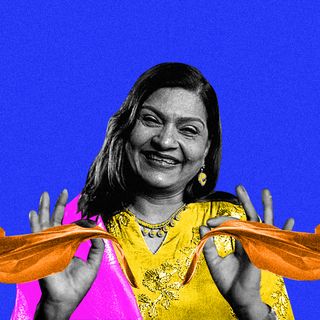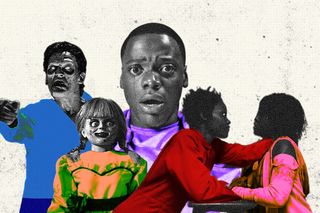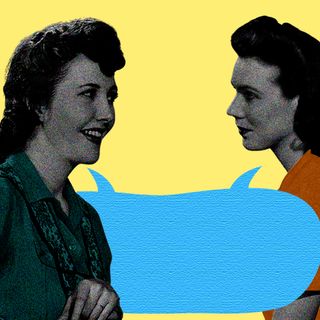
How Representation in Horror Films Creates Space for Our Most Urgent Fears
Now, the terrors — racism, sexism, climate change — aren’t so imaginary.

Perhaps the most genre-defining scene in the history of horror films is one from The Exorcist (1973). In it, 12-year-old Regan grabs a crucifix and violently penetrates herself with it, her voice nightmarishly distorted, her mouth spewing blasphemous words. It is a gruesome thing to witness: representing a fear that is almost too unspeakable – the chastity of a little girl on the verge of puberty forcibly taken from her by a demonic entity.
The scene speaks to how the horror film genre has always been an archive of our deepest, darkest fears – recording society’s id and its changing story. There’s arguably no better way to know ourselves than to know what we collectively fear the most.
In The Exorcist, the opening sequence features soundscapes and visuals evoking the Arab “other” – the demon here is a hypersexual statuette found amid the unknown desert sands in Northern Iraq.
In Regan’s possessed body, Western society saw what it feared about its own sweet twelve-year-old girls; their sexual purity being threatened by two things: the loss of faith and the absence of a father figure. Subsequently, whatever happens to Regan is an indirect result of the unthinkable consequences of eroding institutions like the nuclear family, Christianity, and the gender roles that accompany both.
Since its inception, the stylistic elements of horror cinema have changed – but broader themes remained centered on the feelings of a “universal” individual who was meant to stand in for humanity as a whole, and how they responded to the crises of their times. Sometimes, it was the fear of the radioactive fallout from nuclear war. Others, it was fears of the Red – the communist, perverted and depraved “other” who threatened the American way of life. Alien and Invasion of the Body Snatchers are examples of these, where horror blends in with sci-fi to encompass largely reactionary fears about outsiders.
The question at the heart of the genre, then, is: whose fears, exactly, do these films represent?
A return to the status quo was always the movie’s end – the monstrous entities defeated, peace once again returning. In other words, the status quo was preferable – peaceful, placid, and always under the shadow of something uncanny. And while these fears are supposedly universal, it is only the already privileged for whom an upset in the status quo is the most frightening thing imaginable. For others, this upset is just what is needed.
The anxieties of the cis-het, Christian white men these films portrayed thus inevitably revolved around the loss of control.
Related on The Swaddle:
In ‘Multiverse of Madness,’ Grief Lies at the Heart of Horror
But for many others, the status quo was never peaceful. It was, in fact, the horrific, the terrifying, the abject. “There looms, within abjection, one of those violent, dark revolts of being, directed against a threat that seems to emanate from an exorbitant outside or inside, ejected beyond the scope of the possible, the tolerable, the thinkable,” notes philosopher Julia Kristeva in Powers of Horror; An Essay on Abjection.
Overwhelmingly, women have been the subjects of horror – they have been entered, stabbed, cut up, killed, eaten, and even worn in a string of films that, in representing the anxieties around the female body, ended up torturing it.
For a long time, it seemed like there were only two possibilities for women in horror: a restoration to the status quo or an irreversible, horrific change. Women’s bodies were then fertile (literally) ground for not only representing conservative fears but also expressing their consequences.
But over the years, the way we as a culture began to imagine women’s bodies itself has undergone a shift. Even as overtly anti-establishment politics declined, the last two decades have seen a shift in what we considered political. Marginalized bodies, their experiences, and their location in the societal feeding chain have all become livewires of the cultural conversation, forever changing what was once taken for granted.
In 2020, right in the aftermath of #MeToo, TimesUp, and an overall cultural reckoning with violence, power, and sex, there came The Invisible Man – an H.G. Wells classic retold to represent the horror of gaslighting. Incidentally, the term itself came from Gaslight (1944), but it acquired the catharsis it needed with The Invisible Man simply for the way that female protagonists are subjects of horror without being objects of it. The protagonist Cecelia is subject to torment the way many women in horror are, but the villain isn’t just one bad man or demon. It’s an entire institutional set-up built to not believe women — a nuance that few other films in the past have ventured to incorporate. In being forced to navigate a culture of disbelief at women’s stories, Cecelia’s horror becomes ours; we don’t simply watch her but we experience it, painfully aware of what she’s going through.
Other modern movements like Black Lives Matter were, in comparison to their counterparts from the 1960s and 70s, were more focused on enacting cultural shifts than political ones. They began conversations outside the formal seats of power, where everyone is accountable and beholden to introspect their own identities and privileges. Then, a cultural reckoning: the enemy wasn’t external, but within. It could even be ourselves – not as individuals, but as identities with histories of power.
Related on The Swaddle:
Feminist Filmmakers Are Reinventing Horror Cinema
And so it came to be that horror began to depict domestic violence, as with The Invisible Man, within the larger context of utter alienation by a system. Contrast this with The Shining (1963) – a masterpiece in its own right – where a man’s descent into madness is depicted through the way he terrorizes his wife and son, but from his perspective rather than hers.
The story of horror’s revival and its inversion of the uncanny is incomplete without Jordan Peele’s Get Out – a film where evil is white supremacy and the birth of the nation that is America. It contains all the elements of horror that disturb us, with one fundamental difference: the horror isn’t the future, it’s the present and, more importantly, the distant past. Us (2019) similarly holds a mirror up to America, showing its own dark double back to itself and exposing the hypocrisies of the exalted stories it told about itself and its progress. The genre as a whole moved from cinematic representations of abstract fears to critique with a capital C – asking us to reexamine what we think we fear and showing us what we should fear instead.
This arguably paved the way for more indie explorations of fear that would not have been as feasible earlier. In 2020, amid the height of tensions around immigration around Brexit, there was His House, a film about immigration from the immigrant’s point of view. It is as horrific, surreal, and elevated as any others representing fears around invasion and yet, rather than sympathizing with those who fear the other, the other’s fears cast whiteness itself in an unfamiliar, uncanny light. In other words, where whiteness was formerly the point of view, it has now started to get upended into something grotesque.
Alongside films that explored and subverted identities (whiteness, masculinity), there are also those that have begun to explore inequality and class in new ways. Parasite (2020) was one that shot to mainstream success for depicting inequality in ways that make aspiration, wealth, and even the polite benevolence of wealth turn malevolent. “They’re nice because they’re rich,” observes Chung-Sook in the film.
If The Exorcist was the archetypal possession story involving a mother and daughter, Under the Shadow (2016) is its own resurgence as its own uncanny double. A Persian-language film set in Tehran in the 1980s, it shows a mother and daughter, Dorsa, caught in a cat-and-mouse game with a djinn who tries to possess Dorsa. Here, too, are absent fathers, atheist mothers, and a malevolent spirit. But the spirit here comes from a missile, a manifestly more modern location for it to reside. The context is, contrary to the placid suburban bliss of The Exorcist, a warzone and the PTSD that comes from living in one.
That any of these films achieved the mainstream success they did isn’t a fluke or a coincidence, but signals a shift in our greater political consciousness too. With the help of social justice movements turning the gaze back into society, horror films began to reflect our own darkness back to us – rather than seeking the scares from elsewhere.
Still, blockbuster hits that had to do with religious possession remain a staple with The Conjuring and Insidious franchises – both haunting stories of yore and, ultimately, conservative at their core. Even as evil itself has begun to change, these films serve as reactionary throwbacks to the misogyny that lies lurking in the depths of faith-based horror. But rather than being the mainstream, the success of these franchises can now be read as outliers – even loving homages to the old guard of horror – even as the landscape shifts.
When the people who were formerly “othered” are telling the stories, the stories point to the audience’s sensibilities and aren’t afraid of placing the blame for misery and terror where it ought to be.
The present crop of horror films then force us to reexamine what abjection is: is it us or is it the state of the world itself? With more diverse people telling the story of our times, it quickly becomes obvious that it isn’t what wakes us up but what keeps us up at night that congeals into the darkness we’re so terrified to confront.
Rohitha Naraharisetty is a Senior Associate Editor at The Swaddle. She writes about the intersection of gender, caste, social movements, and pop culture. She can be found on Instagram at @rohitha_97 or on Twitter at @romimacaronii.
Related


Is This Normal? “I Adopt the Accents of People I Spend Time With”
